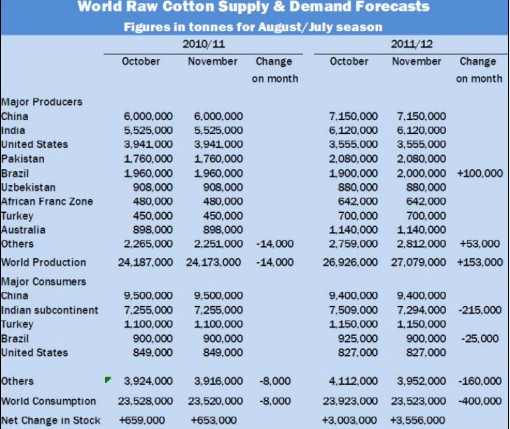|
LAHORE (January 21, 2011) : Cotton prices sustained their upward trajectory this week while a strike call by ginners and the commission agents (arthis) in several Punjab towns continued to protest against withholding tax of 3.5 percent on turnover of agriculture products. With New York cotton futures (ICE) prices again skirting around U.S. Cents 150 per pound this week, fibre prices got an impetus as current crop supplies peter out in the ensuing months. Clear demand for more cotton by the Chinese for the new crop (2011-2012), Indian restraint in exporting its cotton surpluses and increasing demand for lint in many textile manufacturing centers around the world have imparted additional strength to cotton prices. Continuing global demand for sundry commodities, ample cash money floating around the world in many emerging markets and talk of easing of the recession and hope for better global economy has again started a flurry of buying in the commodity complex. Though hopes for global economic recovery, however slow it may be, has spurred buying in the commodity markets since 2010, but now with crude oil prices flirting with U.S. Dollars 100 per barrel may diminish hopes for a wholesome global economic recovery any time soon. Anyhow, spectacular rise in cotton prices, a jump of ninety three percent during 2010, takes the cake in the commodity complex. During the first of this fortnight it appeared that cotton futures prices (ICE) would cool down, only to surge again at midweek to approach 150 cents a pound for the key March 2011 contract. It may recalled that cotton prices had set a record high level of 159.12 cents a pound on 22 December, 2010 when they overran the record set earlier 150 years ago during the American civil war. Hedge funds have reportedly again built up their long positions in the belief that fibre prices may hopefully rise again to higher levels. Indian cotton supply being mired in bureaucratic red tape and charges of malfeasance and mishandling, global supplies are unlikely to ease till this imbroglio is dissipated by the concerned authorities. Some Indian exporters believe that cotton exports could be controlled or curbed if simply an export duty of seven or ten percent was imposed instead of employing labyrinthine formulae to manage cotton prices. Be that as it may, according to cotton merchants the global cotton trade continues to face continuing uncertainties while India sits on its pile of surpluses, negating principles of free and fair trade. In the mean time, the Pakistan Cotton Ginners Association (PCGA) has issued it seedcotton (Kapas/Phutti) arrivals report for the current season (August 2010-July 2011) till the 15th of January 2011 showing receipts of 10,760,252 lint equivalent bales of domestic size against last years receipt of 12,239,959 bales or a shortfall of 12.09 percent. From this quantity, Pakistani mills are said to have lifted 9,316,243 bales, while the exporters have bought 446,600 bales. Ginners retain an unsold stock of 997,409 bales in both ginned and loose form. This report indicates that seedcotton arrivals have been somewhat higher than anticipated earlier. Therefore, it is projected that the current season (2010-2011) could yield an output of nearly 11.5 million domestic size bales on an ex-gin basis, which would be a better output than envisaged earlier. However, mills consumption in Pakistan for the prevailing season is still being estimated between 14 million to 14.5 million domestic size bales, necessitating a total import of two million to 2.5 million domestic size bales. Exporters have again entered the market and it is possible that they may be able to ship up to 500,000 local size bales this season. The deficit arising from this configuration needs to be imported, about half of which may already have landed on Pakistani shores or may be under shipments some time soon. The trouble with Pakistan is that we rely too much on spinning cotton and much less man-made fibres. As recently pointed out by Gohar Ejaz, Chairman of the All Pakistan Textile Mills Association (APTMA), Pakistani mills spin 80 percent cotton and 20 percent man made fibre (MMF) against the world ratio of 40 percent cotton and 60 percent manmade fibres. Thus a more practical and judicious fibre mix could make fibre supply to the Pakistan spinning industry more flexible and workable. Moreover, more value addition to the textile products will also help. In another development, the Pakistan Garments Manufacturers are seeking government assistance following the decision of the Turkish government which reportedly increased import duty from 9 percent to 52 percent on Pakistani textiles. This proposal of the Turkish government will hurt the garment industry and its exporters which needs to be discussed with the Turkish government. The strike of commission agents and ginners against the imposition of 3.5 percent withholding tax is reported to be continuing as also appearing in print media as decided by the Aujman-e-Arthian Ghalla Mandi from Rahimyar Khan, Sadiqabad, Khanpur and Liaqatpur in Punjab. Anyhow, the notional prices idea of seedcotton (Kapas/Phutti) in both Sindh and Punjab reportedly ranged from Rs 3,900 to Rs 4,600 per 40 kilogrammes. The price idea for lint in both Sindh and Punjab was said to have ranged from Rs 9,500 to Rs 10,500 per maund (37.32 Kgs) in a tight market. On the global economic and financial front, equity prices slipped again on Wednesday as reports of sizeable losses were announced by Goldman Sachs. Fear still lurks in the Eurozone where doubts remain regarding any early economic recovery as it continues to struggle with its debt crisis. In China, continuation of inflation and fears of possible housing industry bubbles bursting out remain areas of concern. Unemployment in United States, the United Kingdom, Eurozone and Japan continues to breed pessimism about any early global economic recovery. The most important feature of this week is the meeting of China's president Hu Jintao with President Barack Obama in U.S.A. The two countries have signed export deals worth U.S.Dollars 45 billions between them which are expected to add a quarter of a million jobs in the United States. The rise of China as an economic power is phenomenal. It has not happened suddenly but has resulted from hard work, foresight, economic and political planning and exploring all the mutually beneficial trade with several countries since the past three decades. China has about two trillion dollars worth of currency reserves from which it is investing wisely and diversely. For instance, it is lending money to Spain and other Eurozone countries to stabilize their currencies. China has also lent U.S. Dollars 200 billions to the emerging markets world-wide, which is double the amount which has been lent by the World Bank. Besides the United States, China is also investing in Australia, Africa, India and elsewhere in the five continents which should assist in rehabilitating the downtrodden world economy. This approach by China should help stabilize the wobbling world financial system and also create a more viable global financial infrastructure. |
|
Cotton prices maintain upward trend
Updated: 2011-1-21 Source: Business Recorder

Recommended News
Photo Gallery
Most Popular



